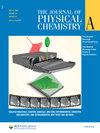Molecular Dynamics study of ice-vapor interactions via the quasi-liquid layer
IF 2.781
引用次数: 43
Abstract
Molecular dynamics simulations of ice Ih in a slab geometry with a free basal (0001) surface are carried out at 250 K in order to study the structure and dynamics of the ice/vapor interface, focusing on processes associated with sublimation and deposition. Surface melting, which results in the formation of a quasi-liquid layer, causes about 8% of the molecules originally constituting the surface bilayer to leave their crystal lattice positions and form an outer, highly mobile sublayer. Molecules in this sublayer typically form two H bonds, predominantly in a dangling-O orientation, with preference for a dangling-H orientation also evident. The remaining 92% of the quasi-liquid layer molecules belong to the deeper, more crystalline sublayer, typically forming three H bonds in an orientational distribution that closely resembles bulk crystalline ice. Transitions between the quasi-liquid layer and the first underlying crystalline bilayer were also observed on the molecular dynamics simulation time scale, alb...准液体层中冰-蒸气相互作用的分子动力学研究
为了研究冰/蒸气界面的结构和动力学,在250 K下进行了具有自由基底(0001)表面的平板几何中的冰Ih分子动力学模拟,重点研究了与升华和沉积相关的过程。表面熔化导致形成准液体层,导致原来构成表面双分子层的大约8%的分子离开其晶格位置,形成一个外部的、高度移动的亚层。这个亚层中的分子通常形成两个氢键,主要是在悬o取向上,也明显倾向于悬H取向。其余92%的准液体层分子属于更深、更结晶的亚层,通常形成三个氢键,其取向分布与大块结晶冰非常相似。在分子动力学模拟时间尺度上,还观察到准液体层和第一底层晶体双分子层之间的转变。
本文章由计算机程序翻译,如有差异,请以英文原文为准。
求助全文
约1分钟内获得全文
求助全文

 求助内容:
求助内容: 应助结果提醒方式:
应助结果提醒方式:


